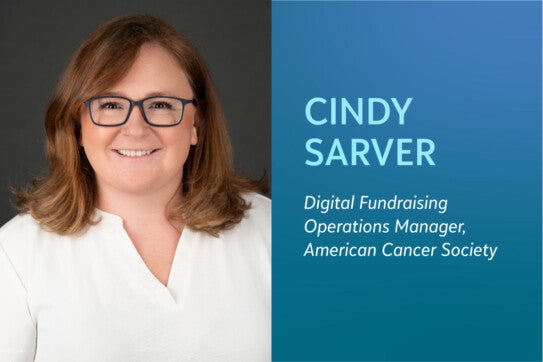Changemaker Spotlight: Cindy Sarver, American Cancer Society

This Q&A series aims to provide readers with valuable insights from changemakers across the social impact community.
Cindy Sarver is the digital fundraising operations manager at American Cancer Society (ACS), playing a pivotal role in advancing the fight against cancer through innovative digital fundraising initiatives. She is a champion of American Cancer Society’s mission, spearheading initiatives that inspire hope, empower communities, and ultimately contribute to the eradication of cancer worldwide.
Q1: What influenced your decision to work in the nonprofit sector, and what brought you to the American Cancer Society?
I’ve always been drawn to mission-driven work and wanted a career where I could make a meaningful impact in people’s lives. The nonprofit sector offered a unique opportunity to align my professional skills with my personal values, especially around service, community, and purpose.
What brought me to the American Cancer Society was not only the strength of the mission but also the organization’s national reach and reputation for innovation in fundraising and patient support. I wanted to be part of something bigger than myself, an organization making a real difference every day, and ACS felt like the right place to do that.
Q2: What are your responsibilities as the digital fundraising operations manager at American Cancer Society?
I oversee the execution of our digital fundraising infrastructure to ensure we’re supporting both national campaigns and local events effectively. My role involves managing reporting and analytics, optimizing donor journeys across digital platforms, and streamlining systems to increase efficiency for our field and support teams.
I also work closely with cross-functional teams to implement automations, maintain data integrity, and develop tools that empower staff and volunteers to fundraise more effectively. At the core, my goal is to make sure we’re leveraging digital tools in smart, strategic ways that help advance our mission and grow our impact.
Q3: Can you tell us more about what makes the digital fundraising for Relay For Life so successful, which just earned the #6 spot in the 2024 U.S. Top 30 Peer-to-Peer Fundraising Programs list?
The success of digital fundraising for Relay For Life is rooted in the powerful combination of mission, community, and innovation, paired with a deeply dedicated volunteer base. Relay is more than an event; it’s a movement led by passionate volunteers who give their time, energy, and heart to the fight against cancer. That volunteer-driven spirit is what makes Relay so personal and impactful.
From a digital perspective, we focus on creating tools and resources that make it easy for participants to share their stories, connect with others, and fundraise effectively. Whether it’s mobile-friendly platforms, social media integration, or automated email and coaching tools, we strive to meet people where they are and help them succeed.
Behind the scenes, we’re constantly using data to refine our strategies, streamline systems, and support both volunteers and staff in growing their local efforts. That blend of heart, community leadership, and strategic digital support is what’s helped Relay For Life earn its spot as the #6 peer-to-peer fundraising program in the U.S., and continues to drive our success year after year.
Q4: What areas of digital fundraising do you recommend nonprofits focus on, even when they may have budget or resource restrictions?
When working with limited budgets or resources, I recommend nonprofits focus on four key areas of digital fundraising: donor engagement, data integrity, automation, and volunteer and fundraiser support.
First, prioritize clear and consistent donor communication. Even with minimal tools, leveraging email and social media effectively can go a long way in building relationships and telling your organization’s story. Authentic, mission-driven messaging often resonates more than high-cost campaigns.
Second, invest time in maintaining clean, organized data. Accurate donor and participant data enables you to personalize outreach, track performance, and make strategic decisions that drive growth.
Third, explore low- or no-cost automation options to streamline repetitive tasks. Automations for welcome emails, donation receipts, and fundraising tips not only save staff time but also enhance the experience for supporters.
And finally, never underestimate the value of supporting your volunteers and fundraisers. Empowering them with the right tools, coaching, and encouragement can dramatically increase reach and revenue. They’re often your most passionate ambassadors, and investing in their success even with limited resources can make a measurable difference.
Q5: You were an influential speaker at bbcon 2024 on the session Navigating Bumps: Lessons Learned from Facebook One Year Later. What strategies did you find most effective in communicating with participants to limit the impact on your revenue after changes to the payment process?
First, thank you! Second, that session was such a great opportunity to share insights and connect with peers navigating similar challenges.
One of the most effective strategies we used was proactive and transparent communication. As soon as we were made aware of the changes to Facebook’s payment process, we immediately crafted clear messaging to explain what was happening, how it could effect participants, and what steps they could take to ensure their funds reached the American Cancer Society. We made this information easily accessible across multiple channels; email, social media, event websites, and staff talking points so both participants and internal teams felt informed and supported.
We also focused on empowering fundraisers with alternatives, including tools to create Facebook independent fundraising pages. Throughout, we emphasized the mission and impact of their fundraising, which helped maintain trust and momentum even in the face of disruption.
Ultimately, being timely, honest, and mission-centered in our communication was key to minimizing confusion and limiting the impact on revenue.
Q6: What is one important tactic a nonprofit can implement to enhance their donor’s online donation experience?
One important tactic is simplifying the donation process.
A clean, mobile-friendly donation form with as few clicks as possible can significantly improve conversion rates. Including features like preset giving amounts, a clear mission impact statement, and the ability to make a gift in honor or memory of someone all help donors feel confident and connected to their contribution.
When the process is intuitive, fast, and mission-aligned, donors are more likely to complete their gift and return to give again.
Q7: What is your advice for someone who is interested in pursuing a career in nonprofit digital fundraising?
My advice for someone interested in pursuing a career in nonprofit digital fundraising is to stay curious, stay mission-driven, and be willing to learn across disciplines.
Digital fundraising sits at the intersection of marketing, technology, and relationship-building. So gaining experience in areas like email strategy, social media, data analytics, and donor stewardship will give you a strong foundation. Don’t be afraid to start small; even volunteering to help with a campaign or managing a fundraising page can offer valuable insight.
It’s also important to be fluid and adaptable. This space is constantly evolving, and you’ll often need to adjust quickly in response to both external factors like platform changes or world events and internal shifts in strategy or resources. Being flexible, solution-oriented, and calm under pressure will set you apart.
Most importantly, keep the mission at the heart of everything you do. In nonprofit digital fundraising, success isn’t just measured in dollars raised. It’s about the stories you help tell, the communities you empower, and the impact you help create.



